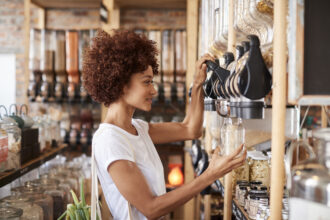Mit dem Frühling kehrt auch die Farbe ins Haus ein. Dies ist die perfekte Zeit, um Ihr Zuhause umweltfreundlicher zu gestalten. Nachhaltigkeit steht heute mehr denn je im Vordergrund. Oxford Dictionaries hat den Begriff „Klimanotstand“ zum Wort des Jahres erklärt und prominente Persönlichkeiten wie Prinz Charles und David Attenborough rufen dazu auf, mehr für die Umwelt zu tun. Aber wie können wir zu Hause handeln, um unserem Planeten zu helfen? Es stellt sich heraus, dass es viele einfache Änderungen gibt, die wir in unseren Alltag integrieren können, ohne es überhaupt zu bemerken, und die sowohl der Erde als auch unserem Bankkonto zugute kommen können.
In der Küche fängt es an. Lebensmittelverschwendung ist ein großes Problem im Vereinigten Königreich. Eine Studie von vouchercodes.co.uk hat ergeben, dass 65 Prozent von uns zugeben, zu viel Essen zu kaufen, das am Ende weggeworfen wird. Nicht nur verschwendet dies Geld, sondern es ist auch schlecht für den Planeten – es macht acht Prozent der gesamten weltweiten Treibhausgasemissionen aus. Die App Too Good To Go bietet einige großartige Tipps, um mehr aus unseren Küchenschränken herauszuholen.
Im Wohnzimmer hingegen können Technologien wie Hive, Amazon Echo und Google Home dabei helfen, weniger Energie zu verbrauchen, ohne großen Aufwand betreiben zu müssen. Alternativ können Sie einfach das Licht ausschalten und auf energieeffiziente Glühbirnen umsteigen, um Energie zu sparen. Darüber hinaus ist es ratsam, Geräte am Hauptstromsatz auszuschalten und nicht nur in den Standby-Modus zu versetzen, da auch ein nicht verwendeter Steckdosenstrom Energie verbraucht.
Im Badezimmer können Sie die Umwelt unterstützen, indem Sie Ihren Wasserverbrauch reduzieren. Wir lieben alle ein entspannendes Bad, aber denken Sie daran, dies als besonderen Genuss zu betrachten und stattdessen auf das Duschen umzusteigen. Auf diese Weise sparen Sie täglich etwa 20 Liter Wasser, wenn Sie dort durchschnittlich acht Minuten verbringen. Es ist wichtig, dass Sie Ihre Dusche dennoch kurz halten, da die Bereitstellung, Behandlung und Erwärmung des warmen Wassers extrem energieintensiv ist.
Im Schlafzimmer hingegen können Sie Pflanzen hinzufügen, um nicht nur etwas Farbe zu verleihen, sondern auch die Luftqualität zu verbessern. Sie könnten auch auf ökofreundliche Bettwäsche umsteigen. Es gibt umweltfreundliche Matratzen, Bettwäsche, Kissen und Bettdecken auf dem Markt. Im Hauswirtschaftsraum ist es nicht nur das Plastik, das schädlich für unseren Planeten ist. Die meisten handelsüblichen Waschmittel enthalten auch chemische Substanzen, die für die aquatische Lebenswelt schädlich sind. Warum probieren Sie nicht Ökobälle aus, um Ihre Kleidung zu waschen? Sie enthalten Reinigungspellets und benötigen kein Waschmittel.äßiger Energieverbrauch, und je länger warmes Wasser fließt, desto höher steigen Ihre Energie- und Versorgungskosten, wie die Experten bei netvouchercodes.co.uk erklären/kubernetes/api/v1/namespaces/assistant_prod/contents/a6316780-da15-4a1d-b1c8-2aca09742f21/%2Fustewater, but it’s also bad for the planet – it represents eight percent of total global greenhouse gas emissions. So, what can we do? The food waste app, Too Good To Go, has some great tips to help us get more out of our kitchen cupboards.
“There’s a lot of confusion around ‘display-until,’ ‘use-by,’ and ‘best-before’ dates and many people throw away food that is still perfectly good to eat. Sell-by, display-until and bestbefore dates are all about quality. These are dates which the food retailer has estimated as the optimum time for the best taste and/or appearance for the product, meaning it’s still safe to eat the product past these dates. Useby dates however should be used strictly as food past these dates is not safe to eat.
We’re all guilty of looking for a bargain when we’re shopping and it’s easy to get sucked into a two-for-one offer we don’t actually need. That’s where the freezer can help out. Most foods can be frozen before the use-by date and then defrosted when needed – even milk, butter and grated cheese.
If there are leftovers after a meal, get creative in the kitchen and repurpose them. Dice bread off-cuts to fry into croutons or blend into bread crumbs, have a go at turning leftover potatoes and vegetables into a hash to enjoy with eggs, or rustle up meringues from separated egg whites.
Making a meal plan for the week and cooking in bulk is one way to prevent foods that may end up going to waste if not used in time.
Another kitchen culprit is single-use plastic that can’t be recycled – but there are alternatives out there. From metal straws and beeswax wraps to replace cling film, to biodegradable bottles of washing up liquid and reusable silicone bags to replace freezer bags, there are ways to reduce the amount of plastic you use.”
In the living room
“Technology such as Hive, Amazon Echo and Google Home are making it increasingly easy to consume less energy without effort,” says Katie Tyndale, founder of Let’s Go Plastic Free (letsgoplasticfree.co.uk). “If, like me, you’re not that tech savvy, then simply turning off lights and swapping to energy efficient bulbs is a great way to save on energy. Also, strange as it may sound, switch appliances off at the main socket rather than powering off, including your TV and computer – even having a redundant socket switched on uses energy. We all love to charge our phones overnight but, again, this is using far more energy than necessary. Plug it in for an hour in the evenings and then in the morning. This should give you an almost-full charge sufficient to last the day.”
In the bathroom
The main way you can help out the environment in this room is to reduce your water consumption. Yes, we all love to have a soak in the bath after a stressful day, but consider making this a treat and switch to showering instead – if you spend the average of eight minutes in there, it’ll save you around 20 litres of water a day. It’s important that you do keep them on the shorter side though, because delivering, treating and heating the hot water for your shower is extremely energy intensive, and the longer you run the hot water, the higher your energy and utility bills rise, as the experts at netvouchercodes.co.uk explain: “Using less water will not only lower your energy costs and conserve water, but will keep that water in the environment for natural geological and ecological cycles.”
The toilet is a key water waster; flushing accounts for around a third of H2O use per day. Don’t panic though, we’re not asking you to stop flushing – there are a few ways to reduce how much water is being used, including installing a dual flush, which is easy to do.
In the bedroom
Adding plants to your bedroom is not only a great way to add some color, they can also improve the air quality and your sleep because they release oxygen and absorb carbon dioxide overnight, helping you breathe better. If you’re worried about forgetting to water your foliage, we’d suggest picking a hardy plant such as a mother-in-law’s tongue – or alternatively, turn to page 18 to find our top picks. However, there can be issues with how environmentally-friendly some plants are – so choose ones that aren’t seasonal and that will die (such as a poinsettia), and if you can, try to propagate plants from cuttings.
You could also take a look at your bedding. There are eco-friendly mattresses available (Silent Night, for example, have manufactured one out of plastic bottles, saving 105 million of them from entering our oceans), and there a wide variety of eco-friendly sheets, pillows and duvets on the market.
In the utility room
“It’s not just the plastic boxes and wrappers that are harmful to our planet,” says Kate. “Most high street laundry detergents also contain chemicals that are harmful to aquatic life. Why not try Ecoballs to wash your clothes? They contain cleaning pellets so don’t require detergent, and last around 1,000 washes, meaning that they’re friendly to your bank balance as well as the planet. Soap nuts are also available – these grow on trees and have been used for thousands of years as a natural laundry detergent. They work so well that as little as 30g is sufficient for a full load.”
Switching to these alternative products are a great way to reduce your impact on the environment
SWAP your usual washing up liquid for…
Choose Biodegradable Washing Up Liquid, £9.49 for 3 with a reusable pump, choosepackaging.co.uk
Each bottle is made from recycled newspaper and plants, so it’s both biodegradable and sustainable. The pumps aren’t recyclable, but they are reusable.
SWAP cling film for…
Bee Green Wraps Beeswax Wraps Starter Pack, £25.49, beegreenwraps.co.uk
While more expensive than cling film, these wraps have the advantage of being reusable. Strong and water-resistant, simply use the warmth of your hands to wrap the product around your food.
SWAP handwash for…
Bower Collective Bio-D Hand Wash Refill 1L, £8.40, and Reusable Glass Dispenser, £5.95, bowercollective.com
All of Bower Collective’s packaging is either recyclable or plastic-free. Purchase your refillable handwash, which is gentle on skin, and fill up your reusable dispenser.
SWAP your usual surface cleaner for…
ALKIMI Multi-Purpose Cleaner, £2, sainsburys.co.uk
ALKIMI uses naturally-derived ingredients to produce nontoxic formulations. This multipurpose cleaner combines orange oil, known as a great degreaser, and anti-bacterial and anti-viral ginger root.
SWAP your laundry detergent for…
EcoEgg Laundry Egg, £9.99, lakeland.co.uk
The EcoEgg contains two types of cleaning pellets which combine to produce a powerful foam that lifts dirt with ease. It lasts for 70 washes and is suitable for even sensitive skin.







